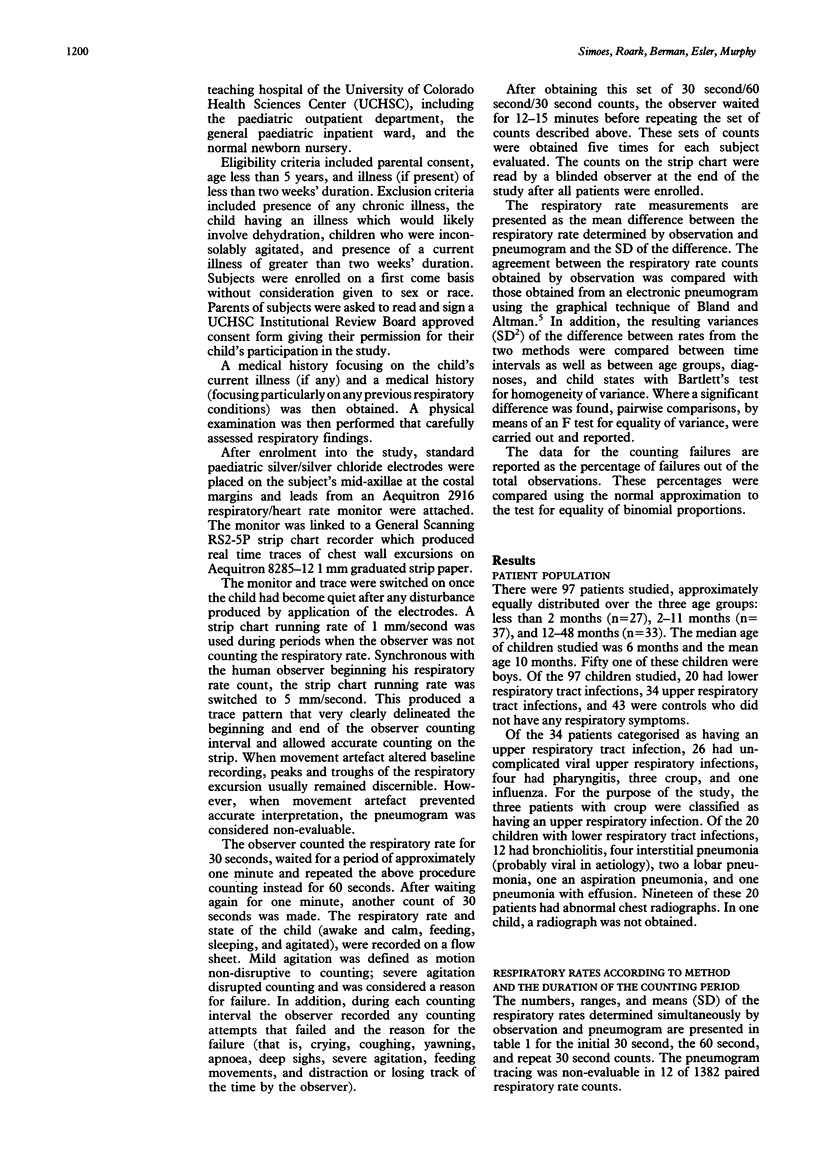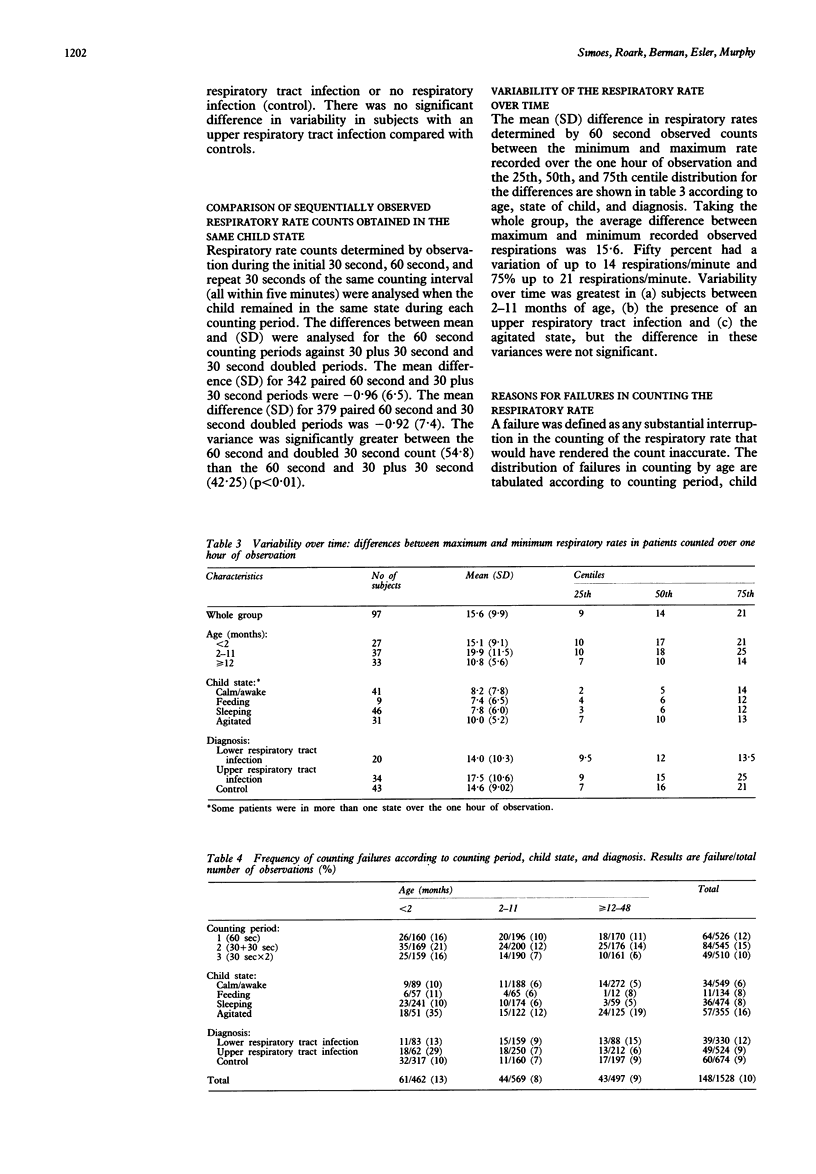Abstract
The respiratory rates/minute of 97 children were monitored every 10-15 minutes over one hour, by an observer and by pneumogram, at which times two 30 second and one 60 second counts were obtained. The children were under 5 years of age with lower respiratory tract infections (n = 20), upper respiratory tract infections (n = 34), or controls without acute respiratory infection (n = 43). The difference between respiratory rate count determined simultaneously by observation and pneumogram in relation to their mean count was analysed for the 60 second counting period, 30 plus 30 second period, and the 30 second period doubled. The mean difference for the 60 second period was 1.79, for the 30 plus 30 second period 1.42, and for the 30 second period doubled 1.72. The variability between respiratory rate counts determined by observation and pneumogram was significantly lower in counts obtained when the subject was sleeping and higher when agitated compared with obtaining a count when the subject was awake and calm or feeding. The variability was also significantly lower in subjects with lower respiratory tract infections compared with those with upper respiratory tract infections and control subjects without respiratory symptoms. In the same patient, over the one hour, 50% of the 60 second counts varied by up to 14 breaths/minute and 75% by up to 21 breaths/minute. The least variability was seen in children with a lower respiratory tract infection, who tended to maintain their rapid breathing in contrast to those with an upper respiratory tract infection and controls without respiratory symptoms. About 10% of initial 30 second counts, 12% of 60 second, and 16% of initial and repeat 30 second attempts to obtain accurate counts failed. Failures occurred more frequently in children <2 months of age and those agitated. The data from this study suggest that one minute's counting either at a stretch or in two blocks of 30 second intervals is better than counting the respiratory rate for 30 seconds, when the child is either awake and calm or when asleep.
Full text
PDF




Selected References
These references are in PubMed. This may not be the complete list of references from this article.
- Ashton R., Connolly K. The relation of respiration rate and heart rate to sleep states in the human newborn. Dev Med Child Neurol. 1971 Apr;13(2):180–187. doi: 10.1111/j.1469-8749.1971.tb03243.x. [DOI] [PubMed] [Google Scholar]
- Berman S., Simoes E. A., Lanata C. Respiratory rate and pneumonia in infancy. Arch Dis Child. 1991 Jan;66(1):81–84. doi: 10.1136/adc.66.1.81. [DOI] [PMC free article] [PubMed] [Google Scholar]
- Bland J. M., Altman D. G. Statistical methods for assessing agreement between two methods of clinical measurement. Lancet. 1986 Feb 8;1(8476):307–310. [PubMed] [Google Scholar]
- Campbell H., Byass P., Greenwood B. M. Simple clinical signs for diagnosis of acute lower respiratory infections. Lancet. 1988 Sep 24;2(8613):742–743. doi: 10.1016/s0140-6736(88)90213-9. [DOI] [PubMed] [Google Scholar]
- Cherian T., John T. J., Simoes E., Steinhoff M. C., John M. Evaluation of simple clinical signs for the diagnosis of acute lower respiratory tract infection. Lancet. 1988 Jul 16;2(8603):125–128. doi: 10.1016/s0140-6736(88)90683-6. [DOI] [PubMed] [Google Scholar]
- Curzi-Dascalova L., Gaudebout C., Dreyfus-Brisac C. Respiratory frequencies of sleeping infants during the first months of life: correlations between values in different sleep states. Early Hum Dev. 1981 Feb;5(1):39–54. doi: 10.1016/0378-3782(81)90069-4. [DOI] [PubMed] [Google Scholar]
- Hoppenbrouwers T., Harper R. M., Hodgman J. E., Sterman M. B., McGinty D. J. Polygraphic studies on normal infants during the first six months of life. II. Respiratory rate and variability as a function of state. Pediatr Res. 1978 Feb;12(2):120–125. doi: 10.1203/00006450-197802000-00011. [DOI] [PubMed] [Google Scholar]
- Morley C. J., Thornton A. J., Fowler M. A., Cole T. J., Hewson P. H. Respiratory rate and severity of illness in babies under 6 months old. Arch Dis Child. 1990 Aug;65(8):834–837. doi: 10.1136/adc.65.8.834. [DOI] [PMC free article] [PubMed] [Google Scholar]
- Richards J. M., Alexander J. R., Shinebourne E. A., de Swiet M., Wilson A. J., Southall D. P. Sequential 22-hour profiles of breathing patterns and heart rate in 110 full-term infants during their first 6 months of life. Pediatrics. 1984 Nov;74(5):763–777. [PubMed] [Google Scholar]


